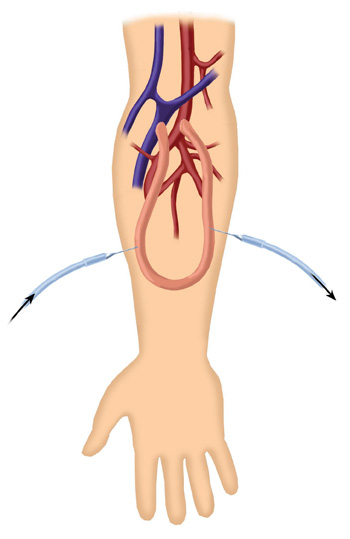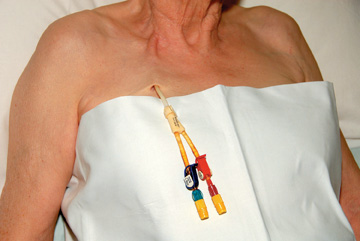
If you are interested in becoming a living kidney donor and are in good health, here are some steps you can take. More details
To perform haemodialysis, an access must be created. An access is a site from which blood can be safely removed and returned to your body. The access site is often referred to as your ‘lifeline’.
There are two main types of haemodialysis access :
Anteriovenous Fistula.
Central Venous Catheters.
 Permanent Access Options
Permanent Access OptionsThe arteriovenous or AV fistula is a type of vascular access, involving a direct connection between an artery and a vein. This connection is made underneath the skin with a surgical procedure that will only require a short stay in hospital. The connection between a vein and artery allows for adequate blood flow during dialysis. This increased blood flow leads to larger and stronger veins and makes repeated needle insertions easier. Fistulas are the preferred vascular access for longterm dialysis patients because they last longer than any other vascular access and are less prone to infection and clotting.
The fistula is usually placed in the forearm. AV fistulas may also be placed in the upper arm, if a previous AV fistula has failed or if the arteries or veins in the forearm are unsuitable for the creation of a fistula. It is preferred that the fistula be placed on the ‘non-dominant’ arm or the arm that you do not use as frequently.
8-12 weeks is usually needed to allow the fistula to properly develop, although it may take longer in some cases. Once the fistula has developed, you are ready to commence haemodialysis treatment. A nurse will insert two needles into the fistula, one for withdrawing blood from the body and the other to return dialysed or filtered blood to the body. Not everyone is suitable for an AV fistula. It can be difficult to create, in some patients, due to small veins and other conditions. Your surgeon may order a test to show the blood flow in your arms, to determine if you are suitable for a fistula.
| PROS AND CONS OF AN ARTERIOVENOUS FISTULA | |
|---|---|
| Pros | Cons |
| Best overall dialysis performance | Visible on the forearm |
| Considered the best vascular access | May take time to develop |
| Less chance of infection than other types of access | May require temporary access while fistula matures |
| Tend to last many years | May bleed after dialysis needles are removed |
| Predictable performance | Some fistulas may fail to mature |
| Steal Syndrome - Poor circulation | |
 Grafts are similar to AV fistulas. Unlike the fistula, which is created by the direct connection of the artery to the vein, the graft is formed by using a synthetic tube to connect the artery to the vein. Therefore, grafts are typically used when patients have small or weak veins that will not develop properly into a suitable fistula. Like a fistula, this type of access is usually implanted under the skin in your arm. A surgeon performs a brief procedure, in order to properly place the
Grafts are similar to AV fistulas. Unlike the fistula, which is created by the direct connection of the artery to the vein, the graft is formed by using a synthetic tube to connect the artery to the vein. Therefore, grafts are typically used when patients have small or weak veins that will not develop properly into a suitable fistula. Like a fistula, this type of access is usually implanted under the skin in your arm. A surgeon performs a brief procedure, in order to properly place the
graft.
The graft is usually a soft, synthetic tube that connects to an artery at one end and a vein at the other. The tube acts like a natural vein, allowing blood to flow through it.
Following the surgery, you may experience pain and swelling, in the area, over the graft for three or four weeks. You will be prescribed pain relief to take during this time. The arm should be kept elevated. After the swelling goes down, a graft can be used for haemodialysis. Grafts can be used repeatedly for needle insertion during dialysis treatment.
| PROS AND CONS OF A GRAFT FOR ACCESS | |
|---|---|
| Pros | Cons |
| Can be readily implanted. | Increased potential for clotting. |
| Predictable performance. | Increased potential for infection. |
| Can be used faster than an AV fistula (within 3 to 4 weeks). | Does not usually last as long as a fistula. |
| Steal Syndrome. | |
Not every fistula or graft will work first time. The success with a fistula is about 70%. Some patients have to come back to have a new fistula made a second or third time.
Occasionally, when a fistula is made it takes too much blood from the hand, resulting in what's called ‘steal syndrome’. If this happens, it may require that the fistula be reversed and another access created for dialysis.
A graft may be prone to developing an infection. If this does develop, you will require a prolonged period of IV antibiotics. Occasionally, a fistula or graft will clot and it will not be possible to use for dialysis. If this occurs it may be necessary for the surgeon to remove the clot to ensure your access functions again.
| Care for Fistulas and Grafts |
|---|
|
|
|
|
|
|
|
|
|
|
|

A dialysis catheter is a flexible, hollow tube which allows blood to flow in and out of your body. They are most commonly used as a temporary access for up to three weeks. This is often undertaken when a patient first needs dialysis immediately and is waiting for a fistula or graft to mature.
They are also used when a permanent access fails and a patient is too unstable to delay treatment. Catheters can be placed in a number of different locations, including the neck, upper chest or upper leg (femoral vein).
After a catheter has been placed, needle insertion is not necessary to receive haemodialysis treatment, dialysis lines are directly connected onto the catheter.
| PROS AND CONS OF A DIALYSIS CATHETER | |
|---|---|
| Pros | Cons |
| Dialysis can be performed immediately. |
Not ideal as permanent access. |
| Easy removal and replacement. | May cause narrowed central veins. |
| Avoids needle insertion for each treatment. | Blood flow may not be sufficient to complete your dialysis treatment. |
Protecting your dialysis access is crucial to you. The following tips will help you care for your dialysis line:
When you are discharged home, from hospital, you will be given an emergency pack containing:
Please keep this pack with you at all times. In the unlikely event that the catheter becomes damaged or leaks, lie flat with your legs elevated. Place the blue clamp from the emergency pack above the leak as close to your exit site as possible and contact the unit immediately.
Remember – keep sharp objects such as razors or scissors away from your dialysis line. In the unlikely event of your dialysis catheter falling out, lie flat with your legs elevated, place gauze or a clean towel over the area and apply pressure for at least 5 minutes or until the bleeding has stopped. Contact the unit immediately.
Never open the clamps or sealing caps between treatments. If you feel or observe fever, chills, redness, swelling, pain at exit site or, feel generally unwell, contact the unit immediately, as you may have a catheter infection that will need to be treated.
Catheters can cause a number of long-term risks including infection. Catheters that have been in place, for a long time, may cause narrowing or blockage of the central veins in the body, interfere with the functioning of a fistula or cause swelling of an arm or the face. This is sometimes called central venous stenosis. If this occurs, it may be necessary to have a new line inserted.
Poor flow - Catheters may develop a small clot, at the tip, causing poor flow of blood in the line. This can lead to inadequate dialysis and result in you feeling poorly.
In rare cases, catheters that are in place for a long time can become embedded, making their removal very difficult.